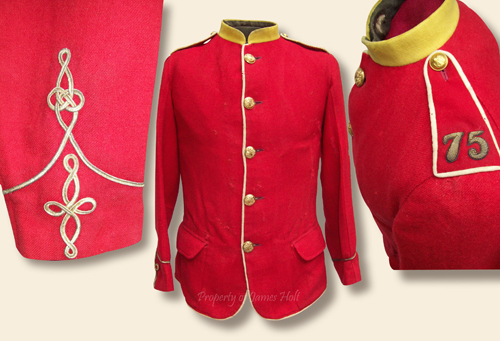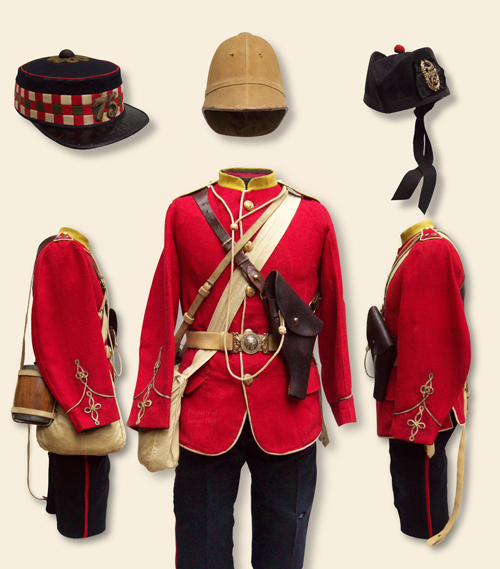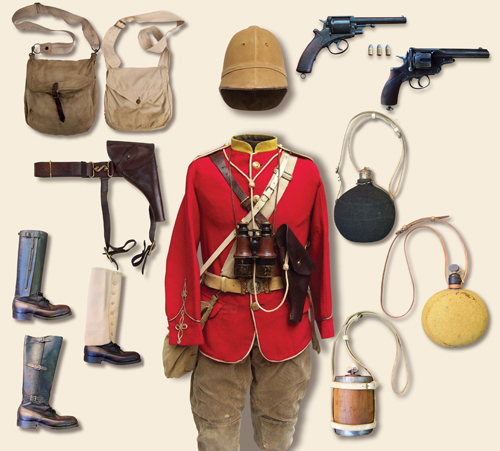
1872 pattern scarlet undress frock, along with the forage cap and sword belt worn by Lieutenant D.L. Baynes of the 75th Regiment in South Africa 1878-79 (James Holt collection)
Denman Lambert Baynes
Born: 1857
Died: 1882
Ensign: 20 July 1870
Lieutenant: 28 October 1871
Captain: 18 December 1880
Hart’s Army list 1878: Baynes listed as “Special service Cape of Good Hope”.
November 1878: Baynes proceeded to Natal on transport service with a fellow officer of the 75th Captain Edward Essex, who was appointed Transport Officer to Colonel Glyn’s (24th) Column, and were employed during the war on the lines of communication and at base.1 Captain Essex fought in, and survived, the slaughter at Isandlwana.
1880-81: Attended Staff College
1881: The Amalgamation of the 75th & 92nd Regiments to form the Gordon Highlanders.
From the London Gazette 19 September 1882: “The Gordon Highlanders, Lieutenant William Baron-Stanton to be Captain, Vice D.L. Baynes, deceased. Dated 26 August
The Gordon Highlanders Memorial, Duthie Park, Aberdeen, bears the following inscription:
“Erected by the Officers, NC Officers and men of the 1st Battalion Gordon Highlanders to the memory of their comrades who were killed or died of wounds or
Disease during the Egyptian Campaign 1882”
Capt.DL Baynes
Leut. AC Pirie
Leut.HG Brooks
According to letters written and posted from Alexandria by a fellow officer of the Gordons, Baynes was on duty at least until Tuesday the 22ndAugust 1882, at which time he went to hospital. Within four days, Baynes was dead.

Letters courtesy of The Gordon Highlanders Museum. The cloth with Baynes’ inscription, James Holt collection.
1. A letter of recommendation for a Private Corbett, who served 21 years with the colors, signed by Baynes. Also shown is the canvas tag from the interior left breast pocket of Baynes’ scarlet serge that has become detached.
2. Excerpt from a letter to his father by Lt. HWD Denne, Gordon Highlanders, written in Ramleh Alexandria, Egypt, 22nd August 1882, indicating his post being relieved by Baynes at 4:30 am.
3. Excerpt from the same eight-page letter expressing Denne’s relief that he will retain his company after Baynes’ arrival, and then further expressing sorrow that Baynes has gone to hospital with dysentery. Baynes dies in hospital four days later. The letter itself adds insight to the build up and action in and around Alexandria prior to the assault on Tel el-Kebir, just over a fortnight away. Note the reference to the pre 1881 numbered regiments and to General Hamley in command (2nd Division) as “our only general”. The author of the letter, Lieutenant Henry William Denne, achieved the rank of Major with the 2nd Battalion Gordon Highlanders. Major Denne was killed in action 21 October 1899, during the Battle of Elandslaagte, 2nd Anglo Boer War.

Details of Lt. Baynes’ frock showing cuff lace, white piping, collar of regimental facing color, shoulder strap piping, and regiment number embroidered in gold. The frock is with five regimental buttons down the front and one per shoulder strap. The cuff is with a single line of lace terminating upward in an Austrian knot with the stylized crows foot lace knot below. (James Holt collection)
Scarlet patrol jacket, scarlet undress frock, scarlet serge, or Indian pattern frock, all valid monikers for this simple lightweight serge frock first introduced in 1872. Aside from the blue patrol jacket favored by staff and some line officers, the scarlet undress frock was also the choice of infantry officers serving in South Africa, 1879.
The simple construction of this frock lent itself well to the temperate climate of South Africa. Slightly oversized to the wearer with ample room in the sleeves it afforded functionality without the constraints of the full dress tunic, used for occasions more formal than active service. The frock is piped white down the front, following along the lower skirt edge, and around the rear vent panels. Shoulder straps were also piped white having the regimental numeral embroidered in gold. The frock typically had two lower hip pockets, either flapped or not. Photos of officers show some variations in pocket configuration as well as a few regimental distinctions in design (91st and 21st), or color (Rifles) For this brief article, I focus on this simple two-pocket frock.
Unlike the full dress counter part, the scarlet serge was devoid of facing color to the cuff. The stand collar, secured by two hooks and eyes and backed by a piece of cloth to prevent chaffing to the neck, was of the regimental facing color. In the case of lieutenant Baynes’ frock, the collar is the yellow of the 75th, or Stirlingshire, Regiment. Rank insignia, a combination of stars and crowns was worn on the collar. Lt Colonels and Lieutenants wore a crown, a crown and star for Colonels and Captains, a star for Majors and 2nd lieutenants. However, 2nd lieutenants and lieutenants seemingly opted not wear any rank distinctions on their collar. Further indication of rank was a combination of gold lace, Austrian knots, and loops to the cuff. Lieutenants a single line, double line for captains, double line for majors with loops to the upper line, double line for colonels with loops to the top and bottom lines.
Photos of officers serving in South Africa 1879 are shown wearing a diverse style of headgear that included the helmet for Foreign Service, forage caps, and the Glengarry. Baynes’ forage cap bears dicing indicating the highland roots of the 75th. Embroidered in gold wire onto a cloth backing and sewn to the dicing is the regimental number. The Glengarry is with regimental badge, black ribbons and red tourie. The forage cap and particularly the Glengarry are both practical choices for performing every day duties in the temperate climate of South Africa.

A fair impression of how an officer might have appeared on active service in South Africa 1879. Note the fullness of the sleeves around the elbow exhibiting the last vestiges of French influence on British uniforms following the Crimea. Baynes frock shows excessive wear particularly in areas where his kit rested against his body, the lower cuff edge, and the pit of the arm. The weave of the serge would rip and snag easily in the thorny scrub found throughout the landscape. The trousers are dark blue serge with a scarlet welt on the outer seam. At the top L-R: forage cap, foreign service helmet of the period, but not belonging to Baynes, (note the stained color and provision for helmet plate), and Glengarry with regimental badge.
(James Holt collection)
Trousers were of dark blue serge, or cloth, with a scarlet welt, or stripe, to the outer seam. Footwear was simple ankle boots of brown or black leather, along with various styles of knee boots, laced and without, or with partial lacing similar in style to “Strathcona” boots. Ankle protection was typically the leather gaiters worn by the ranks or varying styles of canvas, cloth, and leather, the officer purchased privately. The haversack being slung over the left shoulder so as not to impair the use of the 1822 pattern infantry officers’ sword, which hung from a buff, or brown leather sword belt. Securing the belt was a regimental locket (see title photo). The brown leather sword belt could employ the same locket, snake clasp, double or single claw buckle, depending on the officer or regimental peculiarities. The haversack and water bottle would have been the same as used by the ranks in most cases, though officers had available to them other varieties for private purchase. In addition to the sword belt, officers would have had a holster to carry a revolver, paid for and provided by the officer himself, as with the rest of his kit, and holstered on the belt or in a shoulder holster.
There were several models of revolver available for officers to purchase, even the American .45 caliber Colt “Peace Maker”. However, the two most common choices for officers at the time appear to have been the 1872 Adams Mk.III, in .450 caliber, or the .476 caliber Webley No.4, more commonly known as the Webley Pryse. Despite the nomenclature, the .450 Adams was in fact .455 caliber.2 Both revolvers pack a powerful punch and would indeed knock down a determined foe.

See Description below. (James Holt collection, Revolvers and cartridges courtesy of the Grant Rombough collection)
In addition to the blue serge trousers, the cord breeches illustrated above were a common choice. Though intended for use when on mounted duties it appears in the photographic record some officers opted for these over the blue trousers for everyday use. Note the alternative ways to carry the revolver, a brown leather holster worn on the belt, or attached to a strap and hung around the shoulder. Three typical versions of private purchase gaiters worn by officers in 1879 are illustrated. A slightly taller black leather version of the gaiters worn by the ranks, sand colored cloth gaiters with canvas reinforcement and being buttoned up the outer edge, and a three-buckle leather gaiter. The haversack upper left is Baynes’ and was acquired privately. Note the removable shoulder strap and leather front closure. The haversack on the right is the standard other ranks issue with double claw buckle. The top revolver is the 1872 Adams Mk.III (with some loose rounds) and below it the Webley No.4 or Webley Pryse. The blue felt covered glass water bottle is “Bryan’s Army Bottle” and was available for purchase by officer’s at their Dacre Street Westminster location since the 1850s. The khaki/olive felt covered water bottle is by “SA Silver & Co”, Cornhill, London. This water bottle was a popular choice for officers and was still in use during the 2nd Anglo Boer War along with a few other types they manufactured. It is made of wood and covered in very thick felt, other examples are covered with leather. Lieutenant JRM Chard V.C. carried the same SA Silver & Co water bottle shown above throughout the Zulu War and it is on display in the Royal Engineers Museum, Catham. The wooden water bottle in the buff leather cradle is the standard issue pattern 1873 Mk.1 produced by Government contractors. Though carried by many officers, the construction was not any different from those carried by the ranks. The binoculars hung around the neck are an offering from W. Gregory, 51 Strand London.
Though the subject has been covered before by many authors, I can only hope to add to the well of information sought by artists, researchers, collectors, and re-enactors.
James A. Holt
Notes
- Anglo Zulu War 1879 Units Involved, their Officers, Postings and Responsibilities.www.AngloZuluWar.com
- Grant Rombough, in correspondence with the author.
Further source material gleaned from
- Hart’s Army Lists 1878, 79, 80, 82.
- The London Gazette, September 1882.
- The Gordon Highlanders Museum, Aberdeen.
- Dress Regulations for the officers of the army. Horse Guards, War Office 1st November 1874.

I have a lot of old helmets from the Boer War and I am looking to find out about them. I have images of everything. Looking for help so I can liquidate this estate. Any help would be most appreciated.
Howard
Contact us via email Howard.